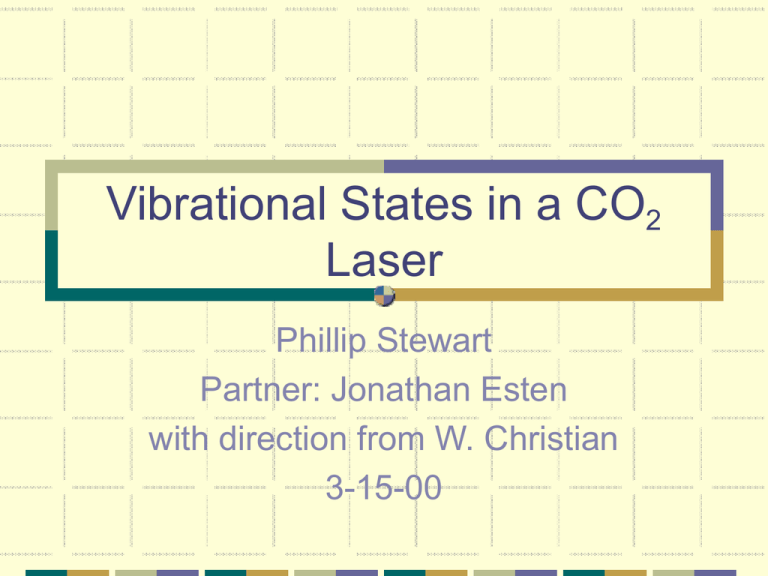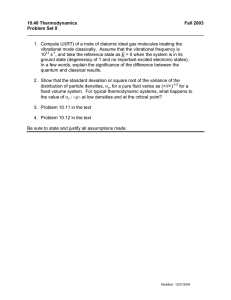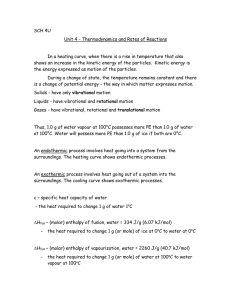Phillip Stewart
advertisement

Vibrational States in a CO2 Laser Phillip Stewart Partner: Jonathan Esten with direction from W. Christian 3-15-00 Abstract Experiments were performed using a CO2 laser in a 75% He -10% CO2 - 15% N2 gaseous mixture sent through a chopper and into a power meter. Observed and discussed here are the transitions from the (0,0,1) asymmetric vibrational mode to the (1,0,0) symmetric vibrational mode and the transitions from the (0,0,1) asymmetric vibrational mode to the (0,2,0) bending vibrational mode. The Spring constant of the molecule was found to be k = 3628 N/m and the distribution of the P and R peaks looked to be a Boltzmann relationship. Why Study the CO2 Laser? High power and efficiency. Used in cutting and welding in industry. Easily shows the molecular properties of CO2 Apparatus Water Power Meter Mirror Chopper Cathode Laser Anode Grating w/Motor Gas Tank To drain Theory When lasing begins at just under 15,000 Volts, electrons bombard the N2, but they cannot radiate. They excite the CO2 molecules to vibrational states, because their energies are very close to the required level for the asymmetric vibrational state in CO2 More Theory The CO2 laser is characterized by the vibrational and rotational transition states in the CO2 molecule, and the molecules act like simple harmonic oscillators in three distinct ways. Yet More Theory A molecule in a vibrational state also has associated with it many rotational states. Those states have degeneracy 2J+1 and account for the miniature peaks in the data acquired. To see all of these miniature peaks, a chopper must be added to avoid lock-in (Milloni) Milloni, Peter W. “Lasers”, New York: 1988. E0 P-Branch 10.4 R-Branch 9.4 Ratio Chopper Added 1.8 1.6 1.4 Ratio 1.2 1 Series1 0.8 0.6 0.4 0.2 0 0 500 1000 1500 2000 Grating Tilt 2500 3000 3500 Slice of the Graph 1.8 1.6 Power (W) 1.4 1.2 1 0.8 0.6 0.4 0.2 0 3.8 3.9 4 4.1 Grating Tilt (mm) 4.2 4.3 4.4 Analysis So once again concentrating on the 10.4 micron state, we can use well known values for the energies associated with the transitions from the (0,0,1) state to the (1,0,0) state. Knowing this equation: We are able to find the moment of inertia. Using values from Eastham at specific J’s, the calculation proves simple: E0=959.82 cm-1 I=9.654*10-39 g-cm2 These values are close to last year’s. The small differences may be accounted to the different operating voltages used. •Eastham, Derek. Atomic Physics of Lasers. Philadelphia: Taylor and Francis, 1986 Analysis Another quantity that is important to find is the spring constant, k. Because , and , the equations can be combined to get k. E0 = 1388 cm-1 (Milonni) w = 5.226 * 1014 radians/second k = 3628 N/m As expected, this spring constant is huge and thus the displacement of the stretching is quite small (obviously). Reference: Jim Nolan, http://www.phy.davidson.edu/jimn/Welcome.html Conclusions By examining the vibrational and rotational states of the CO2 molecule, the spring constant was found to be k = 3628 N/m. The distribution of the P and R peaks follows a Boltzmann distribution, where the shape of that distribution is highly dependant on the moment of inertia– the smaller the moment of inertia, the more symmetric the peaks.




